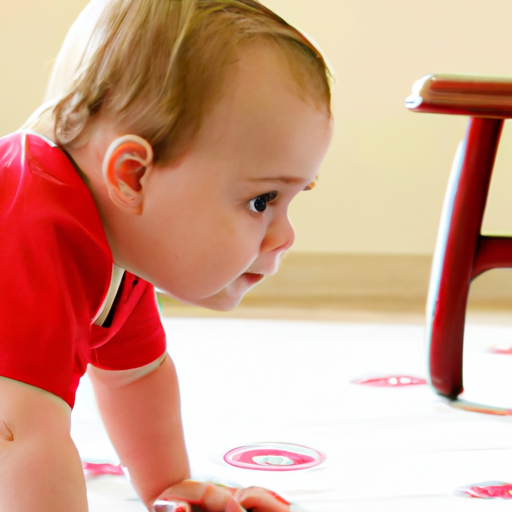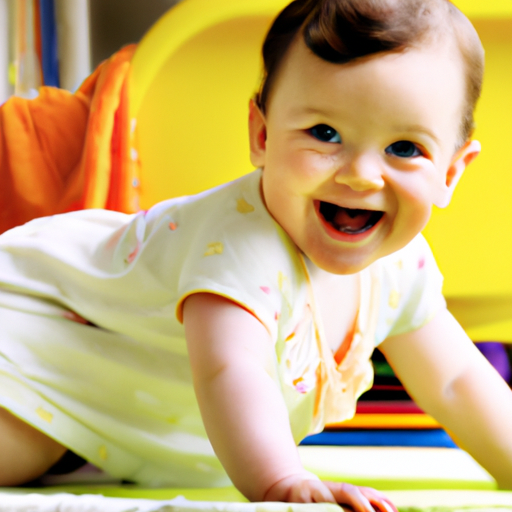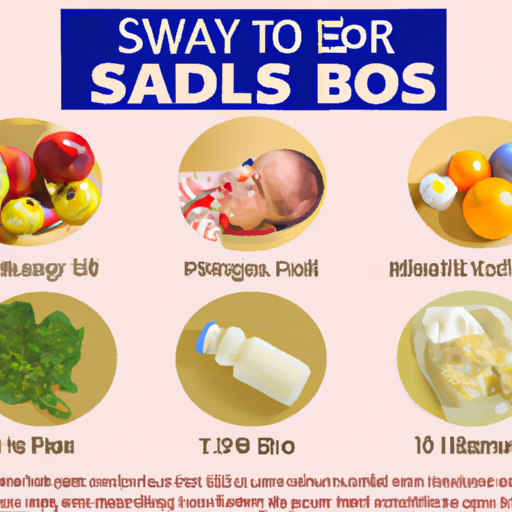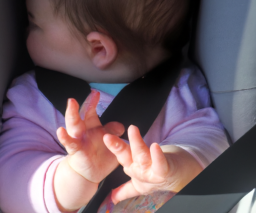So, you’re wondering when your little one is going to start crawling, huh? Well, it’s a common question that many parents ask. Crawling is a major milestone in a baby’s development, and it’s exciting to see them start to explore their world in a whole new way. In this article, we’ll dive into the topic of when babies typically start crawling and what factors can influence their timeline. We’ll also discuss some tips and techniques to encourage your baby’s crawling skills. So, if you’re curious about when you can expect to chase after your crawling bundle of joy, keep reading!
Curious to know more about your baby’s crawling journey? In this article, we’ll go beyond the age range and give you a deeper understanding of the signs that indicate your baby is ready to crawl. We’ll explore the physical and cognitive development milestones that usually precede crawling, as well as the variations in crawling styles. Additionally, we’ll provide you with some strategies and activities to help your baby develop their crawling abilities. Trust us, before you know it, your little one will be racing around the house on all fours! So, let’s discover the fascinating world of crawling and get you all the information you need to support your baby’s development. Crawling is an important milestone for your baby’s overall development. It is an exciting time as it signifies their growing independence and mobility. In this article, we will explore what crawling is, when babies typically start crawling, signs of readiness, different crawling styles, how to encourage crawling, when to be concerned, the stages after crawling, and the interactions that can occur during this stage. Each baby is unique and may start crawling at different ages, so let’s dive in and learn more about this exciting stage of development.
What is crawling?
Definition of crawling
Crawling is the act of moving forward using your hands and knees. It is a crucial step in your baby’s journey towards independent mobility. Crawling helps to strengthen the muscles in their arms and legs, improves their coordination, and enhances their overall physical and cognitive development.
Importance of crawling for baby’s development
Crawling plays a significant role in your baby’s development. It helps them develop crucial skills such as coordination, balance, and spatial awareness. Crawling also enhances their fine motor skills as they learn to use their hands and fingers to explore and interact with their environment. Moreover, crawling stimulates their sensory system and fosters brain development by engaging multiple senses at once.
Typical age range for crawling
When do babies typically start crawling?
Babies generally start crawling between the ages of 6 and 10 months. However, it is essential to note that every baby is different, and some may start crawling earlier or later. Some babies skip crawling altogether and move directly to walking. Remember, there is no “right” age for crawling, as each baby develops at their own pace.
Factors that can affect when a baby starts crawling
Several factors can influence when your baby starts crawling. These factors include their physical strength, muscle development, coordination, and overall readiness. Some babies may take longer to gain strength in their upper body and limbs, while others may need more time to develop their coordination and balance. Additionally, premature babies may reach this milestone a little later than their full-term counterparts.

Physical signs of readiness
Signs that a baby is physically ready to start crawling
There are several physical signs that indicate that your baby is ready to start crawling. These signs include:
- Increased strength in the upper body and limbs: Your baby may begin to show improved muscle strength in their arms, shoulders, and legs. They may start pushing themselves up during tummy time or try to lift their head and chest off the ground.
- Improved coordination: Your baby may begin to coordinate their movements more effectively. They may learn to shift their weight from side to side and rock back and forth during tummy time.
- Increased mobility: Your baby may start scooting or rolling around to explore their surroundings. This increased mobility is a good indication that they are preparing to crawl.
Importance of gaining strength in the upper body and limbs
Gaining strength in the upper body and limbs is crucial for your baby’s ability to crawl effectively. Crawling requires the use of muscles in their arms, shoulders, and legs. By strengthening these muscles, your baby will have better control over their movements and be able to navigate their environment more easily.
Cognitive signs of readiness
Signs that a baby is cognitively ready to start crawling
Cognitive readiness is just as important as physical readiness when it comes to crawling. Here are some cognitive signs that indicate your baby is ready to crawl:
- Spatial awareness: Your baby may display an increased understanding of the space around them. They may look around and show curiosity about objects that are just out of reach.
- Understanding cause and effect: Your baby may begin to understand that their movements can lead to certain outcomes. For example, they may start reaching for a toy and making deliberate attempts to grasp it.
Role of spatial awareness and understanding of cause and effect
Spatial awareness and understanding cause and effect are crucial cognitive skills for crawling. Crawling requires your baby to navigate through their surroundings, avoid obstacles, and reach for objects of interest. By developing spatial awareness and understanding cause and effect, your baby will be better equipped to explore and interact with their environment while crawling.

Different crawling styles
Traditional crawling
Traditional crawling, also known as hands-and-knees crawling, is the most common style of crawling. In this style, your baby crawls on their hands and knees, alternating between them to move forward. This style of crawling allows for optimal coordination and balance.
Commando crawling
Commando crawling, also referred to as army crawling or belly-crawling, involves moving forward on the belly while using the arms and legs to propel themselves. This style of crawling is typically seen in babies who are more comfortable with being in a prone position and prefer to use their upper body strength to move.
Belly crawling
Belly crawling is similar to commando crawling, except that your baby moves forward mainly using their chest and belly. This style of crawling is often seen in babies who are still building their upper body strength and may eventually transition into traditional crawling.
Encouraging crawling
Creating a safe and stimulating environment
Creating a safe and stimulating environment is crucial for encouraging crawling. Clear any potential hazards or obstacles from the floor, and ensure that the space is well-padded and free from sharp edges. Provide ample opportunities for your baby to explore and move around freely.
Placing tempting objects just out of reach
Placing tempting objects just out of reach can motivate your baby to crawl. By strategically positioning toys or objects that capture their interest, you can encourage them to move towards them. This will help them build the confidence to crawl.
Providing tummy time
Tummy time is an excellent way to help your baby develop the muscles necessary for crawling. Place your baby on their tummy for short periods throughout the day, gradually increasing the duration as they become more comfortable and stronger. Tummy time also helps to prevent the flattening of the back of your baby’s head, promoting a rounded head shape.
When should my baby start crawling?
When to be concerned
Possible reasons for delayed crawling
While it is common for babies to start crawling between 6 and 10 months, some babies may experience a delay in reaching this milestone. Possible reasons for delayed crawling include:
- Premature birth: Premature babies may need more time to reach physical and cognitive milestones compared to full-term babies.
- Muscle weakness: Babies with weaker muscle tone may take longer to gain the strength necessary for crawling.
- Gross motor delay: Some babies may have a developmental delay that affects their gross motor skills. This delay can impact their ability to crawl at the typical age range.
When to consult a healthcare professional
If you are concerned about your baby’s crawling development, it is important to consult a healthcare professional. They can evaluate your baby’s overall development and provide guidance and support. Early intervention can be beneficial in addressing any potential developmental delays and promoting optimal progress.
The stages after crawling
Walking
After crawling, the next major milestone in your baby’s journey towards independent mobility is walking. Most babies start taking their first steps around their first birthday, but again, every baby develops at their own pace, so it is essential not to compare them to others.
Running
Once your baby masters walking, they will soon start running. Running allows them to move quickly and explore their environment on a whole new level. It is an exciting time as they continue to develop their coordination and balance.
Climbing
As your baby’s physical skills advance, they may start to show an interest in climbing. Climbing helps them develop strength, coordination, and problem-solving abilities. As they explore and conquer new heights, remember to provide a safe environment and supervision to prevent accidents.
Interactions during crawling
Parent-baby bonding through play
Crawling provides an excellent opportunity for parent-baby bonding through play. Get down on the floor and crawl alongside your baby. Engage in games and activities that encourage them to explore their surroundings and interact with you. These interactions strengthen your bond and create lasting memories.
Encouraging social interaction with other babies
Crawling often brings babies together, creating opportunities for social interaction. Arrange playdates or attend baby groups where your little one can interact with peers who are also at the crawling stage. These interactions promote social skills, sharing, and cooperation.
Conclusion
Each baby is unique, and the age at which they start crawling can vary. It is important not to compare your baby’s progress to others and to remember that they will reach this milestone in their own time. Crawling is an essential stage in your baby’s overall development, promoting physical strength, cognitive skills, and independence. Embrace this exciting time, create a safe and stimulating environment, and provide plenty of opportunities for exploration and play. Enjoy watching your little one take their first steps towards a lifetime of adventures.




